What Kind of Math Is on the CHSPE Test?
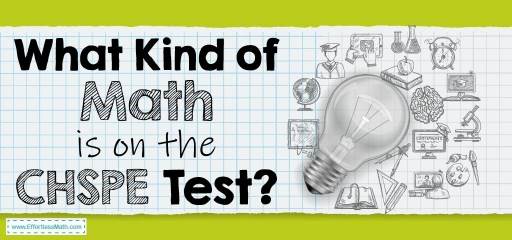
The CHSPE is a standardized test for assessing the skill level of 10th-grade students in California. The purpose of this test is to help students who plan to leave high school early or go to college. Test takers who successfully pass the CHSPE test receive a Certificate of Proficiency from the California State Board of Education, equivalent to a high school diploma.
The CHSPE test has two parts: English Language Arts, Mathematics.
The math section of this test consists of 50 multiple-choice questions and assesses the knowledge of test-takers in the following areas:
- Number Sense and Operations
- Patterns, Relationships, And Algebra
- Data, Statistics, And Probability
- Geometry and Measurement
The total amount of time you have for the test is three and a half hours. Neither of the two sections of the test is timed, and you can divide the time as you like. A basic calculator is also allowed in the CHSPE Math section
In the following section, we briefly review the mathematical topics in the test:
The Absolute Best Book to Ace the CHSPE Math Test
Number Sense and Operations
The first part of the HSPT Math test focuses on topics such as scientific notation, estimation, the order of operation, exponents, operations with real numbers and radicals, and absolute value. Your ability to figure out the numbers and possible operations between them is measured in this section.
Patterns, Relationships, And Algebra
In this section, you should be able to show that in addition to performing algebra operations, you can also identify numerical patterns and relationships between numbers. Questions include topics such as the slope of a line, linear functions, inequalities, solving quadratic, and geometric transformations (dilation, reflection, and transformation).
Data, Statistics, And Probability
This section is for testing your ability with statistics, data interpretation, and data analysis. In this section, you must Make inferences from data, Solve problems with permutations and combinations. Also in this section, you will be faced with some questions of Simple and compound probability.
Geometry and Measurement
The remaining questions are about geometry and measurement, which include solid geometry and coordinates geometry. HSPT test usually includes basic geometry questions. In the geometry section, you should be familiar with Scale drawings and measurements of Perimeter, circumference, area, and volume. You also should know how to use Pythagoras’ theorem.
| math sections | topics | Number of questions | |
| #1 | Number Sense and Operations | Multiplication Property of Exponents, Division Property of Exponents, Zero and Negative Exponents, Powers of Products and Quotients, Negative Exponents and Negative Bases, Scientific Notation, Radicals, Adding and Subtracting Integers, Multiplying and Dividing Integers, Order of Operations, Ordering Integers and Numbers, Integers and Absolute Value, Fractions, and Decimals | 9 |
| #2 | Patterns, Relationships, And Algebra | Simplifying Variable Expressions, Simplifying Polynomial Expressions, Translate Phrases into an Algebraic Statement, The Distributive Property, Evaluating One Variable Expression, Evaluating Two Variables Expressions, Combining like Terms, One-Step Equations, Multi-Step Equations, Graphing Single–Variable Inequalities, One-Step Inequalities, Multi-Step Inequalities, Systems of Equations, Finding Slope, Graphing Lines Using Standard From, Graphing Lines Using Slope-Intercept Form, Writing Linear Equations, Graphing Linear Inequalities, Finding Midpoint, Finding Distance of Two Points, Polynomials | 15 |
| #3 | Data, Statistics, And Probability | Mean, Median, Mode, and Range, Histograms, Pie Graph, Probability Problems, Combinations and Permutations | 12 |
| #4 | Geometry and Measurement | Pythagorean Theorem, Triangles, Polygons, Trapezoids, Circles, Cubes, Rectangular Prism, Cylinder | 14 |
Best CHSPE Math Prep Resource for 2022
Complete List of CHSPE Math Topics
Fractions and Decimals
- Simplifying Fractions
- Adding and Subtracting Fractions
- Multiplying and Dividing Fractions
- Adding Mixed Numbers
- Subtracting Mixed Numbers
- Multiplying Mixed Numbers
- Dividing Mixed Numbers
- Adding and Subtracting Decimals
- Multiplying and Dividing Decimals
- Comparing Decimals
- Rounding Decimals
- Factoring Numbers
- Greatest Common Factor
- Least Common Multiple
Real Numbers and Integers
- Adding and Subtracting Integers
- Multiplying and Dividing Integers
- Order of Operations
- Ordering Integers and Numbers
- Integers and Absolute Value
Proportions, Ratios, and Percent
- Simplifying Ratios
- Proportional Ratios
- Similarity and Ratios
- Percentage Calculations
- Percent Problems
- Discount, Tax and Tip
- Percent of Increase and Decrease
- Simple Interest
Algebraic Expressions
- Simplifying Variable Expressions
- Simplifying Polynomial Expressions
- Translate Phrases into an Algebraic Statement
- The Distributive Property
- Evaluating One Variable Expressions
- Evaluating Two Variables Expressions
- Combining like Terms
Equations and Inequalities
- One-Step Equations
- Multi-Step Equations
- Graphing Single–Variable Inequalities
- One-Step Inequalities
- Multi-Step Inequalities
- Systems of Equations
Linear Functions
- Finding Slope
- Graphing Lines Using Standard Form
- Graphing Lines Using Slope-Intercept Form
- Writing Linear Equations
- Graphing Linear Inequalities
- Finding Midpoint
- Finding Distance of Two Points
Exponents and Radicals
- Multiplication Property of Exponents
- Division Property of Exponents
- Zero and Negative Exponents
- Powers of Products and Quotients
- Negative Exponents and Negative Bases
- Scientific Notation
- Radicals
Polynomials
- Writing Polynomials in Standard Form
- Simplifying Polynomials
- Adding and Subtracting Polynomials
- Multiplying Monomials
- Multiplying and Dividing Monomials
- Multiplying a Polynomial and a Monomial
- Multiplying Binomials
- Factoring Trinomials
- Operations with Polynomials
Geometry and Solid Figures
Statistics and Probability
Functions
- Function Notation
- Adding and Subtracting Functions
- Multiplying and Dividing Functions
- Composition of Functions
FAQs:
Is the CHSPE Math test hard?
If you take enough time to prepare for the CHSPE test, it will not be difficult for you.
How do I study for the CHSPE Math?
How you prepare for the CHSPE Math test is very important. You can use good prep books to prepare well for the CHSPE Math test. You can also use online practice tests for further practice after studying the CHSPE exam courses.
How is the CHSPE Test Scored?
In the CHSPE Math test, the minimum passing score is 350. For more information, you can click here.
Looking for the best resource to help you succeed on the CHSPE Math test?
The Best Books to Ace the CHSPE Math Test
CHSPE Math Workbook 2020 – 2021 The Most Comprehensive Review for the Math Section of the CHSPE Test
Related to This Article
More math articles
- Top 10 6th Grade MEAP Math Practice Questions
- The Ultimate 6th Grade K-PREP Math Course (+FREE Worksheets)
- How to Find Vector Components?
- How to Understand the Real Number Line
- Full-Length 7th Grade IAR Math Practice Test-Answers and Explanations
- FREE CHSPE Math Practice Test
- How to Solve a Quadratic Equation by Graphing?
- ASVAB Math Formulas
- 4th Grade SBAC Math Worksheets: FREE & Printable
- Conic Sections
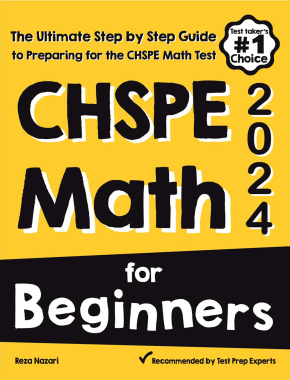
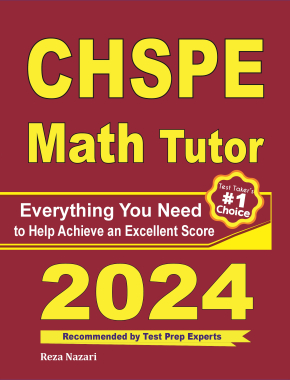
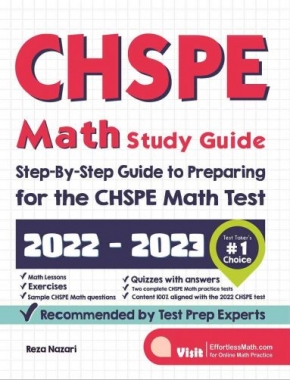
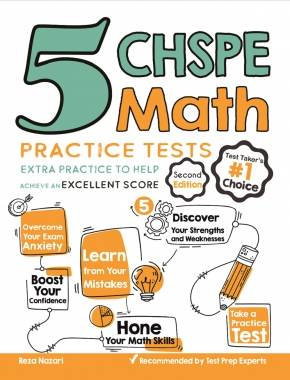
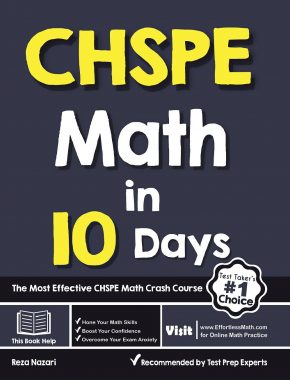
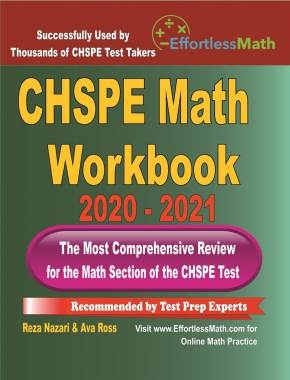
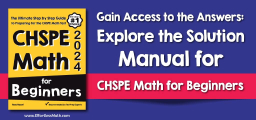









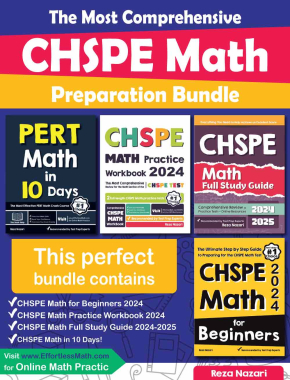
What people say about "What Kind of Math Is on the CHSPE Test? - Effortless Math: We Help Students Learn to LOVE Mathematics"?
No one replied yet.